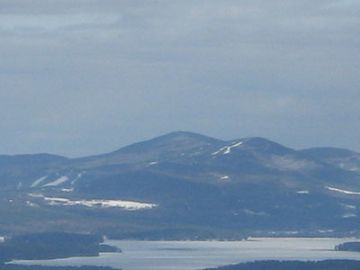Belknap Mountain facts for kids
Quick facts for kids Belknap Mountain |
|
|---|---|

Belknap Mountain (left) as seen from Red Hill
|
|
| Highest point | |
| Elevation | 2,382 ft (726 m) |
| Prominence | 1,842 ft (561 m) |
| Listing | #47 New England Fifty Finest |
| Geography | |
| Location | Gilford, in Belknap County, New Hampshire |
| Parent range | Belknap Mountains |
| Topo map | USGS West Alton |
Belknap Mountain is a mountain located in Belknap County, New Hampshire, United States. You can find it south of Lake Winnipesaukee. The mountain, the county, and the nearby Belknap Mountains are all named after Jeremy Belknap (1744–1798). He was a famous preacher, historian, and author who wrote a book called The History of New Hampshire. Belknap Mountain is part of the Belknap Mountain State Forest.
The very top of Belknap Mountain is the highest point in Belknap County. Even though it's not one of the tallest mountains overall, it stands out a lot. This is because the land around it is much lower. This makes it one of the fifty most "prominent" peaks in New England. "Prominent" means it rises high above its surroundings. To the northwest of Belknap Mountain is Gunstock Mountain. This is where the Gunstock Mountain Resort ski area is located. At the very top of Belknap Mountain, you can see an active fire tower. This tower helps spot forest fires.
Belknap Mountain is part of the watershed for the Merrimack River. This river eventually flows into the Gulf of Maine in Massachusetts. Water from the east and northeast sides of Belknap Mountain flows into Poorfarm Brook. From there, it goes into Lake Winnipesaukee, then the Winnipesaukee River, and finally the Merrimack River. Water from the west side flows into the Gunstock River and then into Lake Winnipesaukee. The south side of the mountain drains into Manning Lake. This water then goes into Crystal Lake, which is where the Suncook River starts. The Suncook River also flows into the Merrimack River.
What is Belknap Mountain Made Of?
Belknap Mountain and the mountains around it are part of something called the White Mountain Magma Series. This means they were formed by igneous rocks. Igneous rocks are created when hot, melted rock (magma) cools down and hardens.
How Belknap Mountain Formed
Scientists believe these mountains formed from volcanic activity. This happened during the Jurassic period, which was about 200 to 150 million years ago. Imagine a time when volcanoes were very active in this area! This volcanic activity caused a lot of melted rock to spread across much of New Hampshire.
Over millions of years, wind, water, and ice caused erosion. Erosion slowly wore away these volcanic rocks and the rocks underneath them. The Belknap Mountains we see today are what's left after all that erosion. It's like a huge sculpture carved by nature! Scientists can study the different types of rocks here to learn about the mountain's long and interesting history.
Images for kids


